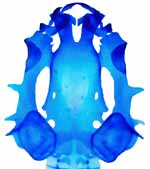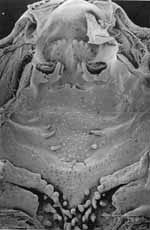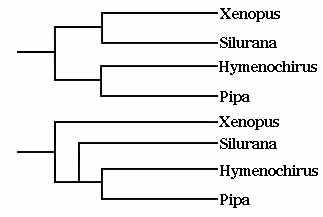 My Research Interests
My Research Interests
 My Research Interests
My Research Interests
My research focuses on studies of evolution and phylogenetic reconstruction using both morphological and molecular data and integration of data sets. Primary research focuses on systematics, evolution, and development of amphibians and reptiles, although recent projects have also included killifish. I also have an interest in conservation biology. Click here for a list of my publications.
Some of the projects that I am currently working on include:
My research philosophy can be summed up in the following diagram:


I use histological and clearing and staining techniques to examine the morphology of tadpole skeletons. We track the development of bones as cartilaginous larval structures ossify prior to and during metamorphosis. At left is a photograph of the chondrocranium (larval skull) of Agalychnis callydrias, more commonly known as the red-eyed tree frog. Use of characters derived from such studies complement characters of adult morphology and help to further elucidate evolutionary relationships among species.

Scanning electron microscope (SEM) analysis is used to study the internal oral morphology of tadpoles. Oral anatomy provides an insight into the ecology and resources used by different species. These data can also be use to determine evolutionary relationships between species. At left is the roof of the oral cavity of Phyllomedusa boliviana.

I use molecular techniques, such as sequencing of ribosomal DNA genes, as another tool in phylogenetic analysis. At left is an example of two alternative phylogenetic trees of the relationships of the frog genus Silurana tested using molecular data.

Integration of data sets derived from use of these techniques, combined with data from resources such as adult morphology, behavioral analysis, and natural history characteristics is a powerful means by which phylogenetic questions can be addressed. At left is a phylogeny in which larval characteristics were used to relate heterochrony and speciation events in Pseudid frogs

In addition to the work that my students and I do in the lab, field work is also an integral part of my research. Field research is not only important as a means of obtaining specimens and tissues used in lab, but also for studies that can only be done in the field. For example, the sonogram presented below was created using frog calls of L. silvanimbus recorded in a trip to Honduras during the summer of 1996. I have done extensive field work in Central and South America, and I am planning future trips to such places as Vietnam and Australia. Students have taken part in field excursions in the past,and will hopefully continue to do so in the future.


I include students in my research as much as possible. I expect a lot out of my students and I push them to make the most of their research experience by immersing them in current scientific topics. As a result, many of my students (both graduate and undergraduate) have had a successful history of publications and presentations at national meetings. Opportunities for undergraduates are available though the University Undergraduate Research Program and Departmental Summer grants. Opportunities are also available for graduate research through the Department of Biology Master's Degree Program.
At left is a photo of three of my undergraduates, Todd Stevens, Erin Hines, and Peter Larson, who presented at the 1997 UR Undergraduate Research Symposium.
Last modified January 9, 1998.
Return Home